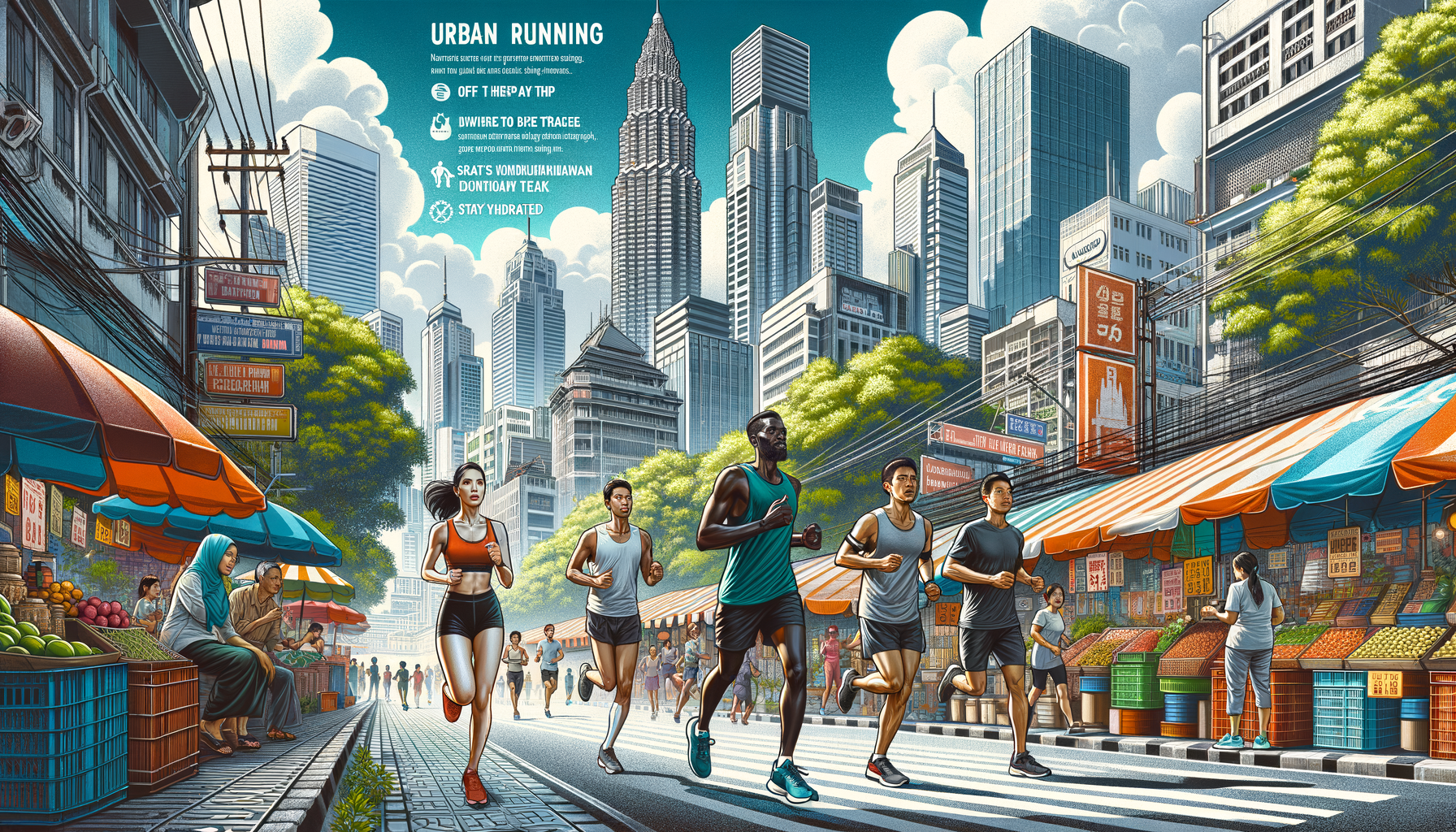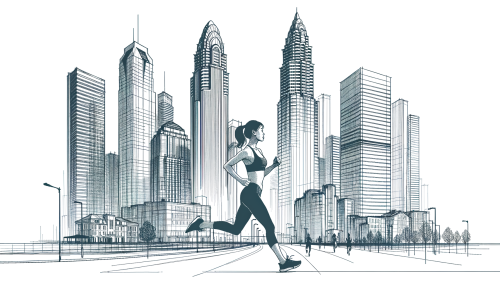Introduction
Running in the City: Tips for Urban Runners in Southeast Asia is a comprehensive guide that provides valuable insights and practical advice for individuals who enjoy running in urban environments. This guide focuses on the unique challenges and opportunities that Southeast Asia’s bustling cities present to runners. From navigating crowded streets and dealing with tropical weather conditions, to finding the best running routes and local running communities, this guide aims to equip urban runners in Southeast Asia with the knowledge and skills they need to have a safe, enjoyable, and fulfilling running experience.
Navigating the Concrete Jungle: Essential Tips for Urban Runners in Southeast Asia

Running in the city, especially in the bustling urban landscapes of Southeast Asia, can be a thrilling experience. The vibrant cityscapes, the mix of modern and traditional architecture, and the diverse cultures make every run an adventure. However, running in the city also presents unique challenges. Here are some essential tips for urban runners in Southeast Asia to navigate the concrete jungle.
Firstly, it’s crucial to plan your route. Unlike running in a park or on a trail, city running involves navigating through busy streets, crowded sidewalks, and traffic. Use a running app or Google Maps to plan your route ahead of time. Try to choose routes that have wide sidewalks or dedicated running paths. In Southeast Asian cities like Singapore and Kuala Lumpur, there are plenty of parks and green spaces that are perfect for running.
Next, timing is everything. The tropical climate in Southeast Asia means it can get incredibly hot and humid, especially in the middle of the day. Therefore, it’s best to run early in the morning or late in the evening when the temperature is cooler. Plus, running during these times means you’ll avoid the peak traffic hours.
Safety should always be a priority when running in the city. Always obey traffic rules and be aware of your surroundings. It’s easy to get lost in your thoughts or your music, but remember to stay alert. Watch out for cars, cyclists, and pedestrians. If you’re running at night, wear reflective clothing or use a headlamp to make sure you’re visible to others.
Hydration is another key factor to consider. The heat and humidity in Southeast Asia can quickly lead to dehydration if you’re not careful. Always carry a water bottle with you and take regular sips throughout your run. If you’re planning a long run, consider bringing a hydration pack or planning your route to pass by public water fountains.
Lastly, embrace the unique aspects of running in Southeast Asia. Take the time to appreciate the beautiful cityscapes, the vibrant street life, and the diverse cultures. Use your runs as an opportunity to explore new areas of the city. Try running in different neighborhoods, or even in different cities if you have the chance. Each run can be a new adventure.
Running in the city, especially in Southeast Asia, can be challenging, but it’s also incredibly rewarding. With the right planning, precautions, and mindset, you can navigate the concrete jungle like a pro. So lace up your running shoes, hit the pavement, and start exploring.
Running in the City: A Comprehensive Guide for Southeast Asian Urban Runners
Running in the city can be a thrilling experience, especially in the vibrant urban landscapes of Southeast Asia. From the bustling streets of Bangkok to the scenic routes of Singapore, urban running offers a unique blend of fitness and exploration. However, city running comes with its own set of challenges. Here are some tips to help you navigate the concrete jungle and make the most of your urban running experience in Southeast Asia.
Firstly, it’s crucial to plan your route. Southeast Asian cities are known for their dense population and heavy traffic, which can make running a bit tricky. Use apps or online maps to find the best routes that offer a balance of safety, scenery, and challenge. Look for parks, riverbanks, or quieter residential areas where you can run with minimal interruptions. In cities like Kuala Lumpur and Manila, early morning runs are recommended to avoid the peak traffic hours and the scorching midday sun.
Next, gear up appropriately. The tropical climate in Southeast Asia means it’s usually hot and humid, so lightweight, breathable clothing is a must. Don’t forget to apply sunscreen and wear a cap or visor to protect yourself from the sun. Also, invest in a good pair of running shoes that provide ample support and cushioning for running on hard surfaces like concrete.
Hydration is another key aspect to consider. The heat and humidity can cause you to sweat more, increasing the risk of dehydration. Carry a water bottle or plan your route around places where you can refill your water. Some cities, like Singapore, have plenty of public water fountains that can come in handy.
Safety should always be a priority when running in the city. Be aware of your surroundings and stay alert for vehicles, cyclists, and pedestrians. It’s also a good idea to share your running route with someone or use a tracking app so that someone knows where you are. In cities like Jakarta and Ho Chi Minh, where the traffic can be chaotic, it’s advisable to run on designated paths or sidewalks whenever possible.
Lastly, embrace the unique aspects of urban running in Southeast Asia. Take the time to appreciate the stunning cityscapes, the blend of modern and traditional architecture, and the diverse street life. Use your runs as an opportunity to explore new areas, discover hidden gems, and immerse yourself in the local culture. In cities like Bangkok, for instance, you can combine your run with a visit to a morning market or a historic site.
Running in the city in Southeast Asia can be an exciting adventure. With the right planning, gear, and mindset, you can overcome the challenges and truly enjoy the experience. Whether you’re a seasoned runner or a beginner, these tips can help you make the most of your urban running journey. So lace up your running shoes, hit the streets, and discover a whole new side of Southeast Asia.
Mastering Urban Running: Strategies and Tips for Southeast Asian City Dwellers
Running in the city can be a thrilling experience, especially in the vibrant and bustling cities of Southeast Asia. The region’s unique blend of modernity and tradition, coupled with its diverse landscapes, offers a unique backdrop for urban runners. However, running in Southeast Asia’s urban areas also presents its own set of challenges. From navigating crowded streets to dealing with the region’s tropical climate, urban running in Southeast Asia requires a different set of strategies and tips.
Firstly, planning your route is crucial. Southeast Asian cities are known for their busy streets and unpredictable traffic. Therefore, it’s essential to map out your running route beforehand. Consider quieter residential areas or parks that are less crowded and offer a safer running environment. Apps like Strava or Google Maps can be handy tools for planning your route, as they provide information on the distance and elevation of your chosen path.
Next, timing is everything. The tropical climate in Southeast Asia means that temperatures can soar during the day, making running uncomfortable and potentially dangerous due to heat exhaustion. To beat the heat, consider running early in the morning or late in the evening when the temperatures are cooler. Not only will this make your run more comfortable, but it will also allow you to avoid the peak traffic hours.
Hydration is another key factor to consider when running in Southeast Asia’s cities. The region’s high humidity levels can lead to excessive sweating, which can quickly lead to dehydration if not properly managed. Always carry a water bottle with you during your runs and consider investing in a hydration belt or backpack for longer distances. Additionally, replenishing your electrolytes is equally important, so consider drinking a sports drink or coconut water, which is readily available in most Southeast Asian countries.
Safety should also be a top priority when running in the city. Always stay alert and aware of your surroundings, especially when running on busy streets or during darker hours. Reflective gear or a headlamp can make you more visible to motorists, and always remember to obey traffic rules. It’s also a good idea to share your running route with a friend or family member, just in case of emergencies.
Lastly, embrace the unique aspects of urban running in Southeast Asia. The region’s cities are rich in culture and history, and running can be a great way to explore and appreciate these elements. Whether it’s the colonial architecture in Singapore, the vibrant street markets in Bangkok, or the ancient temples in Phnom Penh, there’s always something to discover during your run.
In conclusion, urban running in Southeast Asia can be a rewarding experience if you’re well-prepared and mindful of the unique challenges it presents. By planning your route, timing your runs wisely, staying hydrated, prioritizing safety, and embracing the local culture, you can enjoy the thrill of urban running in this vibrant and diverse region. So lace up your running shoes, hit the streets, and experience the exhilarating world of urban running in Southeast Asia.
Conclusion
Running in the city, particularly in Southeast Asia, presents unique challenges and opportunities. Urban runners must navigate crowded streets, varying air quality, and diverse terrains. However, with the right preparation, knowledge of safe routes, appropriate gear, and understanding of local climate and culture, city running can be a rewarding experience. Therefore, it’s crucial for runners in Southeast Asia to adapt their routines and expectations to meet the demands of their urban environment.





